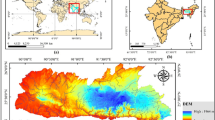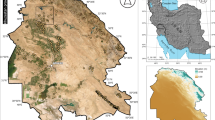Abstract
There is an ever-growing demand for the construction of silty clay stratum tunnels; therefore, effectively controlling the surface settlement caused by tunnel construction has become an important task. Since the physical indexes of silty clay greatly influence strength and deformation, based on the physical and mechanical indexes of 3192 groups in three areas, quantitative and determinative indexes for the subclassification of silty clay are proposed using K-means clustering and the tracking records of the actual project. Then, the soil loss and settlement of different subclassifications of silty clay are studied through the standard Gauss error function. Empirical formulas for calculating the width of the settlement trough and the soil loss rate are proposed. The dispersion of the settlement parameters with different subclassifications indicates that the soil properties of the silty clay strata vary greatly with subclassification, and the influence range of the surrounding soil disturbance caused by excavation also varies. In addition, the change in the soil loss rate with the propulsion of the tunnel face in the same monitoring section is discussed. For subgrade V, the increasing soil loss rate reaches a maximum when the tunnel face reaches the monitoring sections. For subgrades VI1 and VI2, this rate changes mainly during the timeframe spanning from 5 days before excavation to 5 days after excavation. A numerical simulation was also carried out to validate the applicability of the Peck formula for silty clay tunnels. The numerical prediction and field measured data show that when the cover-to-diameter ratio is between 1 and 3, it is reasonable to use the Peck formula to analyze the surface settlement of a silty clay tunnel. This paper can provide guidance based on experience for the subclassification of the soil surrounding rock and for the prediction of the ground surface settlement.













Similar content being viewed by others
References
Al-Shayea NA (2001) The combined effect of clay and moisture content on the behavior of remolded unsaturated soils. Eng Geol 62(4):319–342
Atkinson JH, Potts DM (1977) Stability of a shallow circular tunnel in cohesionless soil. Geotechnique 27(2):203–215
Attewell PB, Farmer IW (1974) Ground deformations resulting from shield tunnelling in London Clay. Can Geotech J 11(3):380–395
Anis Z, Wissem G, Riheb H, Biswajeet P, Essghaier GM (2019) Effects of clay properties in the landslides genesis in flysch massif: case study of Aïn Draham, North Western Tunisia. J Afr Earth Sci 151:146–152
Barton NR, Lien R, Lunde J (1974) Engnineering classification of rock masses for the design of tunnel support. Rock Mech 6(4):189–236
Bergaya F, Theng BKG, Lagaly G (2006) Handbook of clay science. Newnes, Netherlands
Bieniawski ZT (1973) Engineering classification of jointed rock masses. Civil Eng South Afr 15(9):43–353
Chen CL, Zhao CL, Wei G (2014) Prediction of soil settlement induced by double-line shield tunnel based on Peck formula. Rock Soil Mech 35(8):2212–2218
Chen WT, Wang MN, Wang YS, Li YW (2008) Study on index selection of surrounding rock classification for cohesive soil tunnel. Rock Soil Mech 29(4):901–904
Clough GW, Schmidt B (1981) Design and performance of excavations and tunnel in soft clay. Soft Clay Eng Dev Geotech Eng 20:567–634
Dafalla MA (2013) Effects of clay and moisture content on direct shear tests for clay-sand mixtures. Adv Mater Sci Eng 2013:1–8
Deng JL (1990) Grey system theory tutorial. Wuhan, China
Deere DU, Hendron AJ, Patton FD (1967) Design of surface and near-surface construction in rock. In: Proceedings of the 8th US symposium on rock mechanics failure and breakage of rock, New York
Dimitrova RS, Yanful EK (2012) Factors affecting the shear strength of mine tailings/clay mixtures with varying clay content and clay mineralogy. Eng Geol 125:11–25
Dindarloo SR, Siami-Irdemoosa E (2015) Maximum surface settlement based classification of shallow tunnels in soft ground. Tunn Undergr Space Technol 49:320–327
Fattah MY, Shlash KT, Salim NM (2013) Prediction of settlement trough induced by tunneling in cohesive ground. Acta Geogr 8(2):167–179
Fattahi H, Bayatzadehfard Z (2019) Application of artificial intelligence methods for estimation of maximum surface settlement caused by EPB shield tunneling. J Eng Geol 12:55
Fisher RA (1992) Statistical methods for research workers. Springer, New York
Golpasand MRB, Nikudel MR, Uromeihy A (2016) Specifying the real value of volume loss (VL) and its effect on ground settlement due to excavation of Abuzar tunnel. Tehran B Eng Geol Environ 75(2):485–501
Guan BS (1964) Rock solidity coefficient of Protodyakonov. Railw Stand Des 4:22–26
Hajihassani M, Kalatehjari R, Marto A, Mohamad H, Khosrotash M (2019) 3D prediction of tunneling-induced ground movements based on a hybrid ANN and empirical methods. Eng Comput-Germany 36:251–269
Han X, Wang F, Lei CH, Yin HL (2017) Study of rules of ground layered settlement induced by shield tunneling. Tunnel Constr 37(4):401–408
Han X, Li N, Standing JR (2007) An adaptability study of Gaussian equation applied to predicting ground settlements induced by tunneling in China. Rock Soil Mech 28(1):23–28
Hasegawa N, Hasegawa S, Kitaoka T, Ohtsu H (2019) Applicability of neural network in rock classification of mountain tunnel. Mater Trans. 60:758–764
Jallow A, Ou CY, Lim A (2019) Three-dimensional numerical study of long-term settlement induced in shield tunneling. Tunn Undergr Space Technol 88:221–236
Kanungo T, Mount DM, Netanyahu NS, Piatko CD, Silverman R, Wu AY (2002) An efficient k-means clustering algorithm: analysis and implementation. IEEE Trans Pattern Anal 7:881–892
Lai H, Zhang J, Zhang L, Chen R, Yang W (2019) A new method based on centrifuge model test for evaluating ground settlement induced by tunneling. Ksce J Civ Eng 23:2426–2436
Li Y, Qi TY, Lei B, Qian WP, Li ZY (2019) Deformation patterns and surface settlement trough in stratified jointed rock in tunnel excavation. KSCE J Civ Eng. 23:3188–3199
Liang Q, Li GJ, Li DW (2011) Some problems on surrounding rock classification of loess tunnels. Chin J Geotech Eng 33(S1):177–183
Lin YM (1995) Theory and practice of rock classification. Peking, China
Liu HX, Li WS, Zha ZY, Jiang WJ, Xu T (2018a) Method for surrounding rock mass classification of highway tunnels based on deep learning technology. Chin J Geotech Eng 40(10):1809–1817
Liu Q, Liu J, Pan Y, Kong X, Hong K (2017) A case study of TBM performance prediction using a Chinese rock mass classification system–Hydropower Classification (HC) method. Tunn Undergr Space Technol 65:140–154
Liu HB, Zhang HZ, Wang J (2018b) Effect of freeze-thaw and water content on mechanical properties of compacted clayey soil. Rock Soil Mech 39(1):158–164
Lu D, Kong F, Du X, Shen C, Gong Q, Li P (2019) A unified displacement function to analytically predict ground deformation of shallow tunnel. Tunn Undergr Space Technol 88:129–143
Mair R, Gunn MJ, O’Reilly MP (1981) Ground movements around shallow tunnels in soft clay. In: Proceedings of 10th international conference on soil mechanics and foundation engineering, Netherlands
Malizia JP, Shakoor A (2018) Effect of water content and density on strength and deformation behavior of clay soils. Eng Geol 244:125–131
McCabe BA, Orr TLL, Reilly CC, Curran BG (2012) Settlement trough indicators for tunnels in Irish glacial tills. Tunn Undergr Space Technol 27(1):1–12
Mitchell JK, Soga K (1976) Fundamentals of soil behavior. Number 2:111–130
Niu WL, Li TB, Xiong GB, Zhang GY (2011) Support vector machine based intelligence rock mass classification method. J Eng Geol 19:88–92
O’Reilly MP, New BM (1982) Settlements above tunnels in the United Kingdom–their magnitude and prediction. In: Proceedings of the 3rd international symposium, London
Ou CY, Hsieh PG (2011) A simplified method for predicting ground settlement profiles induced by excavation in soft clay. Comput Geotech 38(8):987–997
Panagiotopoulos I, Voulgaris G, Collins MB (1997) The influence of clay on the threshold of movement of fine sandy beds. Coast Eng 32(1):19–43
Peck RB (1969) Deep excavations and tunnelling in soft ground. In: Proceedings of 7th international conference on soil mechanics, Mexico
Qi ZM, Li PF (2010) Control standard of ground surface settlements in metro section shallow tunnel. J Beijing Jiaotong Univ 34(3):117–121
Rankin W (1988) Ground movements resulting from urban tunneling. In: Proceedings of 23rd conference of the engineering group of the geological society, London
Shiau J, Sams M (2019) Relating volume loss and greenfield settlement. Tunn Undergr Space Technol 83:145–152
Su YH, Zhang PH, Xiao W (2015) Equivalent circular approximation method for response curve tunnel excavation of dilatant surrounding rock. Chin J Geotech Eng 37(S1):31–35
Terzaghi K (1946) Rock defects and loads on tunnel supports. Cambridge University Press, Cambridge
Van Der Maaten L, Postma E, Van den Herik J (2009) Dimensionality reduction: a comparative. J Mach Learn Res 10:66–71
Vu MN, Broere W, Bosch J (2016) Volume loss in shallow tunneling. Tunn Undergr Space Technol 59:77–90
Wang MN, Chen WT, Liu DG, Tong JJ (2010) Study of unified standard of rocky and soil surrounding rock sub-classification in road tunnels. Rock Soil Mech 31(2):547–552
Wang ZC, Li W, Li SC, Qiu WG, Ding WT (2018) Development of an optimum forepole spacing (OFS) determination method for tunnelling in silty clay with a case study. Tunn Undergr Space Technol 74:20–32
Wu CS, Zhu ZD (2018) Comparative study on ground loss ratio due to shield tunnel with different diameters. Chin J Geotech Eng 40(12):2257–2265
Wei G (2010) Selection and distribution of ground loss ratio induced by shield tunnel construction. Chin J Geotech Eng 32(9):1354–1361
Yalcin A (2007) The effects of clay on landslides: a case study. Appl Clay Sci 38(1–2):77–85
Ye C, Guo Z, Cai C, Wang J, Deng J (2017) Effect of water content, bulk density, and aggregate size on mechanical characteristics of Aquults soil blocks and aggregates from subtropical. China J Soil Sediment 17(1):210–219
Zeng B, Huang D (2016) Soil deformation induced by Double-O-Tube shield tunneling with rolling based on stochastic medium theory. Tunn Undergr Space Technol 60:165–177
Zhang ZX, Zhang H, Yan JY (2013) A case study on the behavior of shield tunneling in sandy cobble ground. Env Earth Sci 69(6):1891–1900
Zhao Y, He H, Li P (2018) Key techniques for the construction of high-speed railway large-section loess tunnels. Engineering 4(2):254–259
Zhu CH, Li N (2016) Estimation method and laws analysis of surface settlement due to tunneling. Rock Soil Mech 37(S2):533–542
Zhou P, Wang ZJ, Xu HY (2017) Stability and sub-classification study on the tunnel surrounding rock of Xigeda strata considering the influence of moisture content. China Civ Eng J 50(12):97–110
Acknowledgements
The authors acknowledge the financial support provided by the National Natural Science Foundation of China (Grant No. 41572275).
Author information
Authors and Affiliations
Corresponding author
Ethics declarations
Conflict of interest
No potential conflict of interest was reported by the authors.
Additional information
Publisher's Note
Springer Nature remains neutral with regard to jurisdictional claims in published maps and institutional affiliations.
Rights and permissions
About this article
Cite this article
Hou, Ml., Ding, Wt., Wang, Xg. et al. Analysis of the Soil Loss and Settlement of Silty Clay with Different Subclassifications. Geotech Geol Eng 38, 5819–5838 (2020). https://doi.org/10.1007/s10706-020-01395-2
Received:
Accepted:
Published:
Issue Date:
DOI: https://doi.org/10.1007/s10706-020-01395-2




